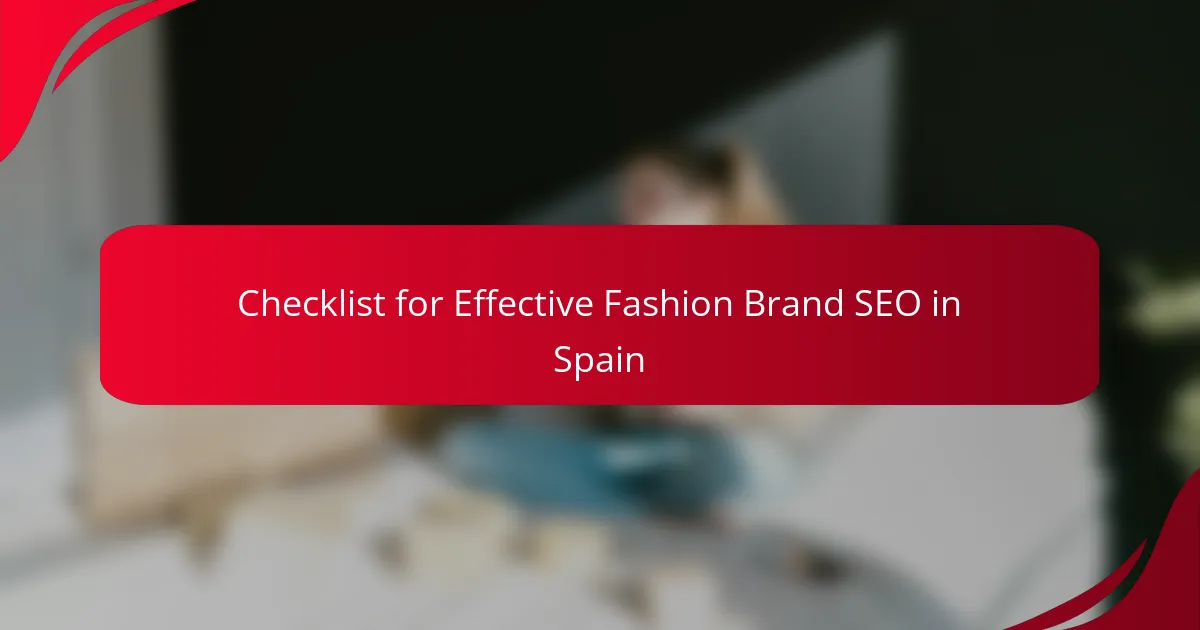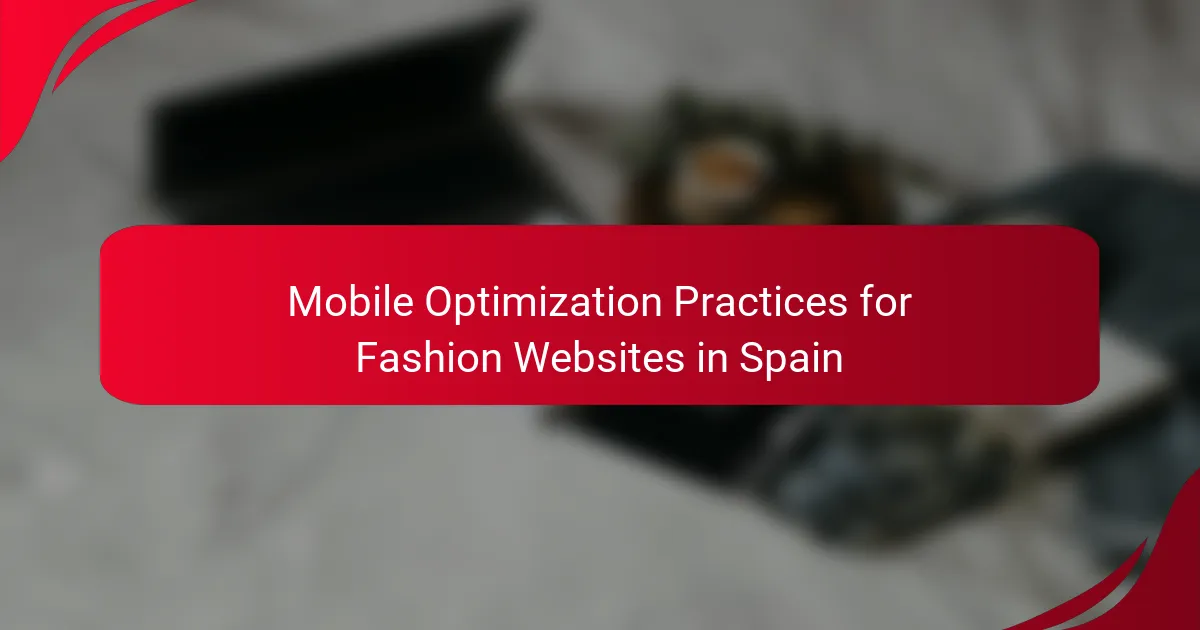Local SEO techniques are essential for fashion brands in Spain looking to enhance their online presence and attract customers within specific regions. By optimizing Google My Business listings, creating localized content, and ensuring mobile compatibility, brands can significantly improve their visibility in local searches. Tailoring content to reflect local culture and trends further engages the target audience, driving more foot traffic and online interactions.
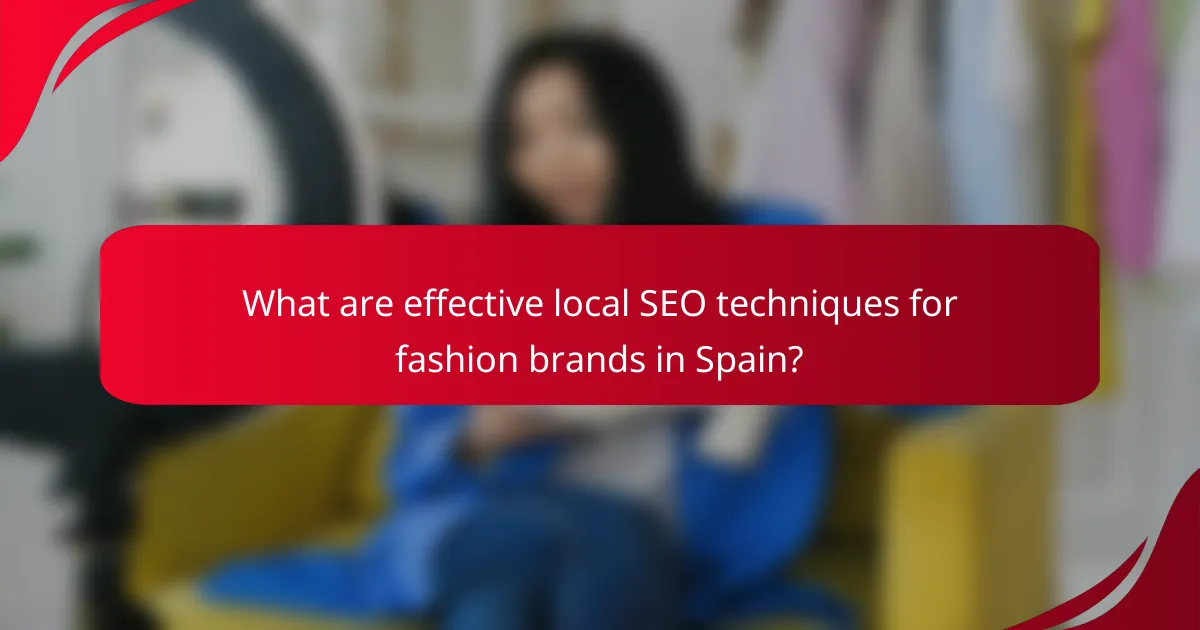
What are effective local SEO techniques for fashion brands in Spain?
Effective local SEO techniques for fashion brands in Spain focus on enhancing online visibility within specific geographic areas. By utilizing strategies like Google My Business optimization, localized content creation, and mobile optimization, brands can attract more local customers and improve their search rankings.
Google My Business optimization
Optimizing your Google My Business (GMB) listing is crucial for local SEO success. Ensure your business name, address, and phone number (NAP) are accurate and consistent across all platforms. Include high-quality images of your products and store, and regularly update your hours of operation, especially during holidays.
Utilize GMB features like posts to share promotions or events, and encourage customers to ask questions. Responding promptly to inquiries can enhance customer engagement and improve your local search ranking.
Localized content creation
Creating localized content helps fashion brands connect with their target audience in Spain. Focus on topics relevant to local trends, events, and culture, incorporating local keywords naturally into your website and blog posts. This approach not only improves SEO but also resonates with local customers.
Consider creating guides or articles that highlight local fashion events or collaborations with local influencers. This not only boosts your brand’s visibility but also establishes your authority in the local fashion scene.
Local backlinks acquisition
Acquiring local backlinks is essential for improving your website’s authority and search rankings. Reach out to local fashion bloggers, magazines, and influencers to collaborate on content or sponsorships. This can lead to valuable backlinks from reputable local sources.
Participate in community events or sponsor local charities to gain exposure and backlinks from local news outlets. Building relationships with other local businesses can also lead to mutually beneficial linking opportunities.
Mobile optimization strategies
With a significant number of users searching for fashion brands on mobile devices, optimizing your website for mobile is essential. Ensure your site is responsive, loads quickly, and provides a seamless user experience on smartphones and tablets.
Consider implementing features like click-to-call buttons and location-based services to enhance usability for mobile users. Regularly test your site on various devices to ensure it meets the needs of your audience.
Customer reviews management
Managing customer reviews is vital for local SEO and brand reputation. Encourage satisfied customers to leave positive reviews on platforms like Google and Yelp, as these can significantly influence potential buyers. Respond to reviews, both positive and negative, to show that you value customer feedback.
Consider implementing a review management system to track and analyze reviews. This can help you identify trends and areas for improvement, ultimately enhancing customer satisfaction and loyalty.

How can fashion brands optimize their Google My Business listings in Spain?
Fashion brands in Spain can optimize their Google My Business listings by ensuring all information is accurate and engaging. This helps improve visibility in local searches and attracts potential customers.
Complete business information
To optimize your Google My Business listing, start by providing complete business information. This includes your brand name, address, phone number, website, and business hours. Ensure that the address is formatted correctly for Spanish locations, using local language and terms.
Additionally, include categories that accurately describe your business, such as “women’s clothing store” or “men’s fashion boutique.” This helps Google match your listing with relevant searches.
Regular updates and posts
Regularly updating your Google My Business listing with posts can significantly enhance engagement. Share news about new collections, promotions, or events to keep your audience informed. Aim to post at least once a week to maintain visibility.
Utilize high-quality images and engaging content in your posts. This not only attracts attention but also encourages customers to visit your store or website.
Utilize Google Q&A feature
The Google Q&A feature allows potential customers to ask questions directly on your listing. Actively monitor this section and respond promptly to inquiries. This demonstrates your commitment to customer service and can influence purchasing decisions.
Consider preemptively adding common questions and answers to your listing. This can include inquiries about return policies, shipping options, or store hours, helping to provide clarity and enhance customer trust.
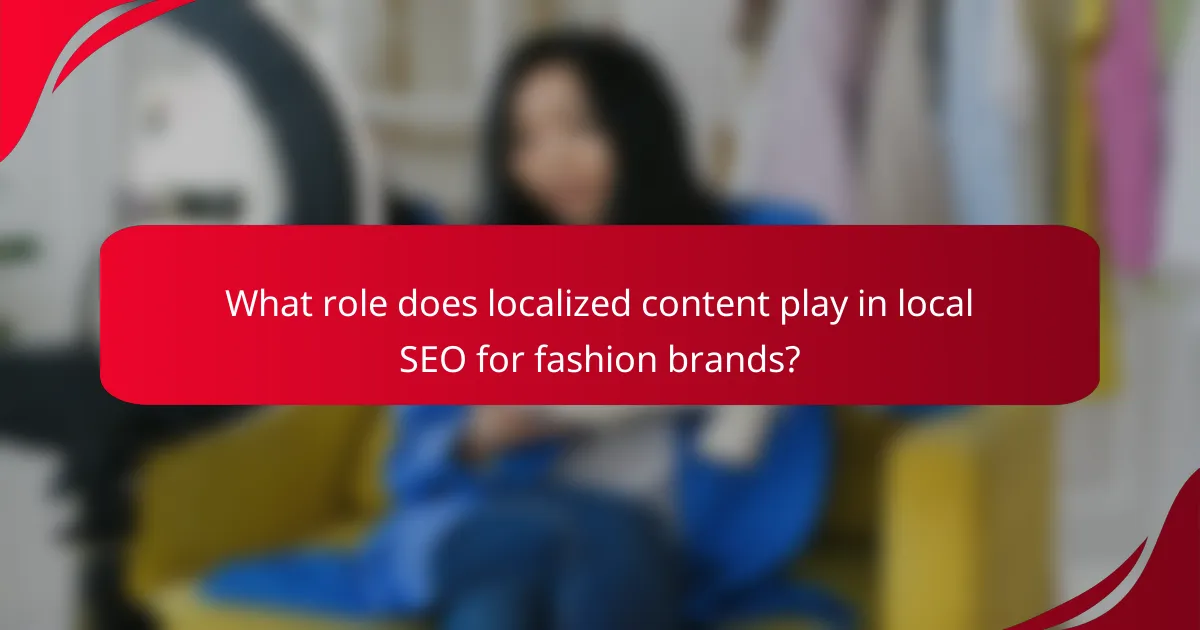
What role does localized content play in local SEO for fashion brands?
Localized content is crucial for local SEO as it helps fashion brands connect with their target audience in specific regions of Spain. By tailoring content to reflect local culture, language, and trends, brands can enhance their visibility in search results and engage potential customers more effectively.
Targeting local keywords
Targeting local keywords involves identifying and using terms that potential customers in Spain are searching for. This can include phrases like “fashion boutiques in Madrid” or “Barcelona street style.” Incorporating these keywords into website content, product descriptions, and blog posts can significantly improve search rankings.
To find effective local keywords, tools like Google Keyword Planner or SEMrush can be beneficial. Focus on long-tail keywords that reflect local intent, as they often have less competition and higher conversion rates.
Creating location-specific landing pages
Creating location-specific landing pages allows fashion brands to cater to different regions within Spain. Each page should feature unique content that highlights local styles, events, and promotions relevant to that area. For example, a landing page for Valencia might showcase summer collections ideal for the region’s warm climate.
Ensure these pages are optimized for local SEO by including local keywords, meta tags, and structured data. This approach not only improves search visibility but also enhances user experience by providing tailored content.
Engaging local influencers
Engaging local influencers can amplify a fashion brand’s reach within specific Spanish markets. Collaborating with influencers who resonate with the target audience can lead to authentic endorsements and increased brand awareness. Consider influencers who align with the brand’s values and aesthetic.
To maximize impact, brands should provide influencers with creative freedom to showcase products in a way that feels natural to their audience. This could involve hosting local events, offering exclusive promotions, or creating co-branded content that highlights the local fashion scene.
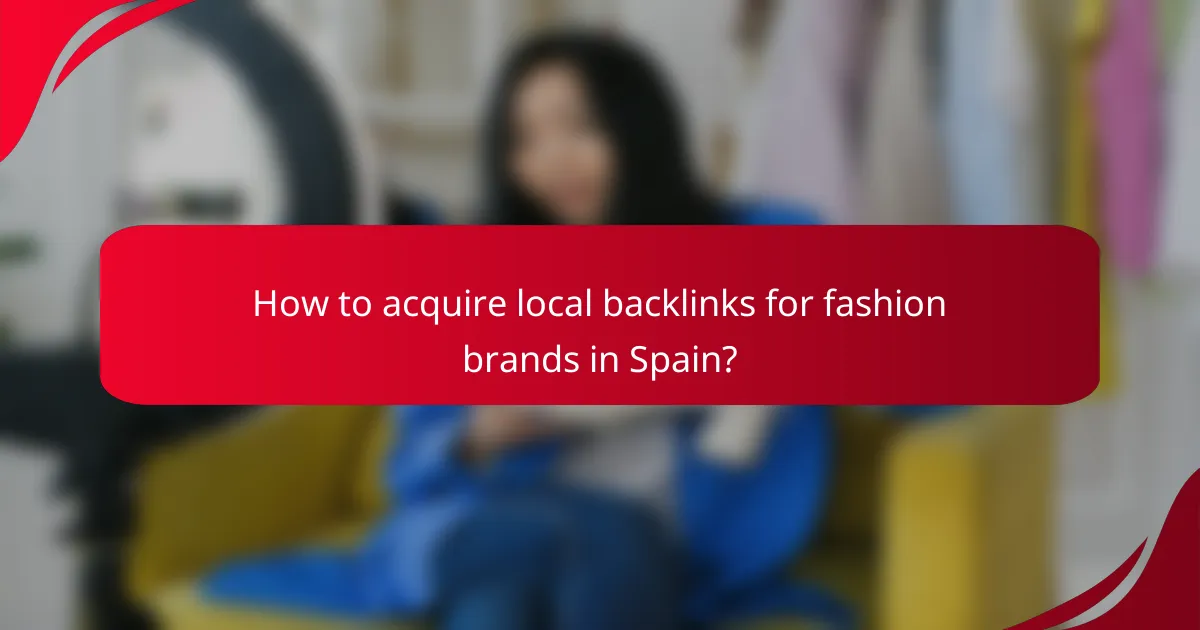
How to acquire local backlinks for fashion brands in Spain?
To acquire local backlinks for fashion brands in Spain, focus on building relationships with local influencers, sponsoring community events, and submitting your brand to local directories. These strategies enhance your online presence and improve local search rankings.
Partnerships with local bloggers
Collaborating with local fashion bloggers can significantly boost your brand’s visibility and credibility. Reach out to bloggers who align with your brand values and audience, offering them products for review or collaboration on content.
Consider hosting a giveaway or a styling session with a local influencer to create engaging content. This not only generates backlinks but also drives traffic to your website from their followers.
Sponsoring local events
Sponsoring local fashion events, markets, or charity functions can provide valuable exposure and backlinks. Look for events that attract your target demographic and offer sponsorship packages that include website mentions and social media promotion.
Participating in these events allows you to network with other local businesses and influencers, further enhancing your backlink profile while showcasing your brand to a relevant audience.
Submitting to local directories
Listing your fashion brand in local directories is a straightforward way to gain backlinks and improve local SEO. Focus on reputable directories specific to Spain, such as Páginas Amarillas or Yelp España, which cater to fashion and retail.
Ensure that your listings are complete and accurate, including your brand’s name, address, phone number, and website. Regularly update your information to maintain consistency across platforms, which is crucial for local search rankings.
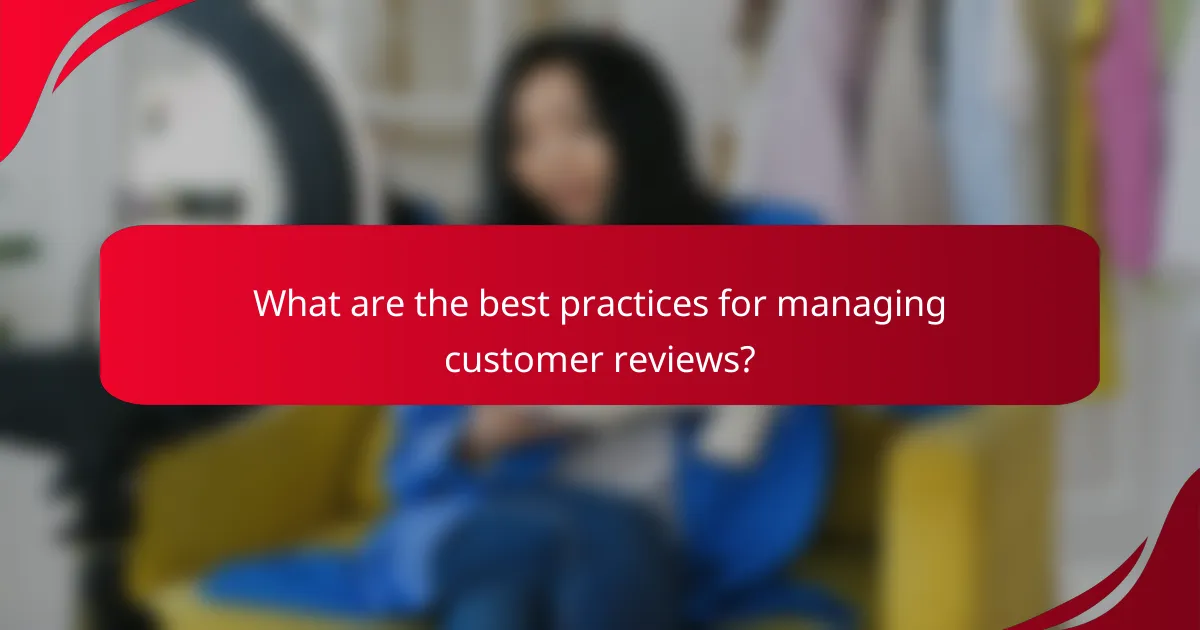
What are the best practices for managing customer reviews?
Effective management of customer reviews is crucial for fashion brands in Spain to enhance their online presence and build trust. Key practices include actively encouraging feedback, responding promptly to reviews, and leveraging positive comments in marketing strategies.
Encouraging customer feedback
Encouraging customer feedback can significantly improve the volume and quality of reviews. Fashion brands should create easy pathways for customers to leave reviews, such as follow-up emails after purchases or links on social media. Offering incentives like discounts or loyalty points can motivate customers to share their experiences.
Brands can also engage with customers on social media platforms, prompting them to share their thoughts and experiences. This not only increases the likelihood of receiving reviews but also fosters a sense of community around the brand.
Responding to reviews promptly
Responding to reviews in a timely manner demonstrates that a brand values customer opinions. Aim to reply to reviews within a few days, whether they are positive or negative. Acknowledging positive reviews can reinforce customer loyalty, while addressing negative feedback shows a commitment to improvement.
When responding, personalize your messages to reflect the customer’s experience. This approach can turn a dissatisfied customer into a loyal advocate, especially if they see that their concerns are taken seriously and addressed effectively.
Leveraging positive reviews in marketing
Utilizing positive reviews in marketing materials can enhance a brand’s reputation and attract new customers. Consider featuring glowing testimonials on your website, social media, or in email campaigns. Highlighting customer stories or photos can create relatable content that resonates with potential buyers.
Additionally, consider creating a dedicated section for customer reviews on your website. This not only showcases positive feedback but also builds credibility, as new customers can see real experiences from others. Regularly updating this section with fresh reviews keeps the content dynamic and engaging.







